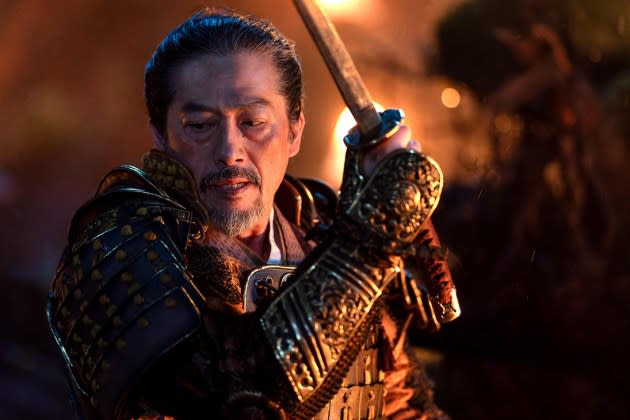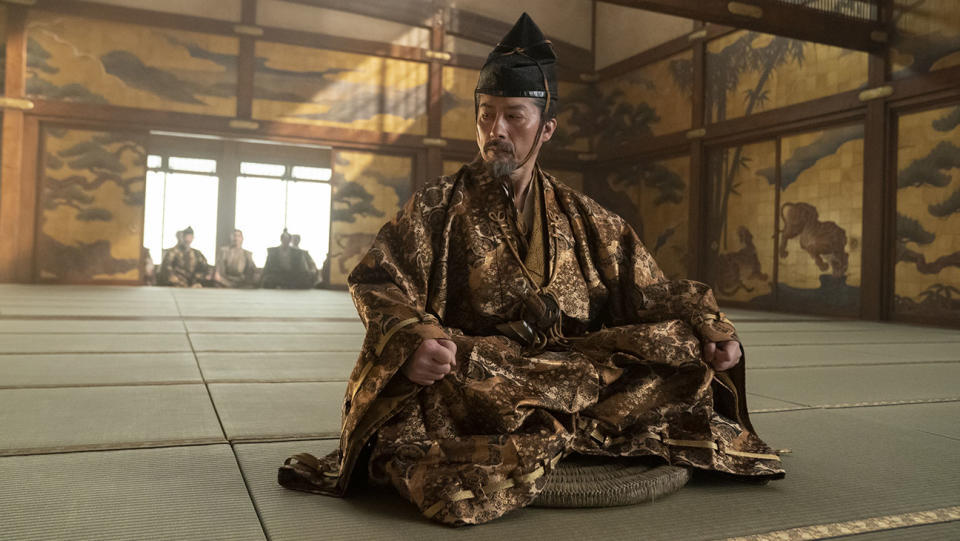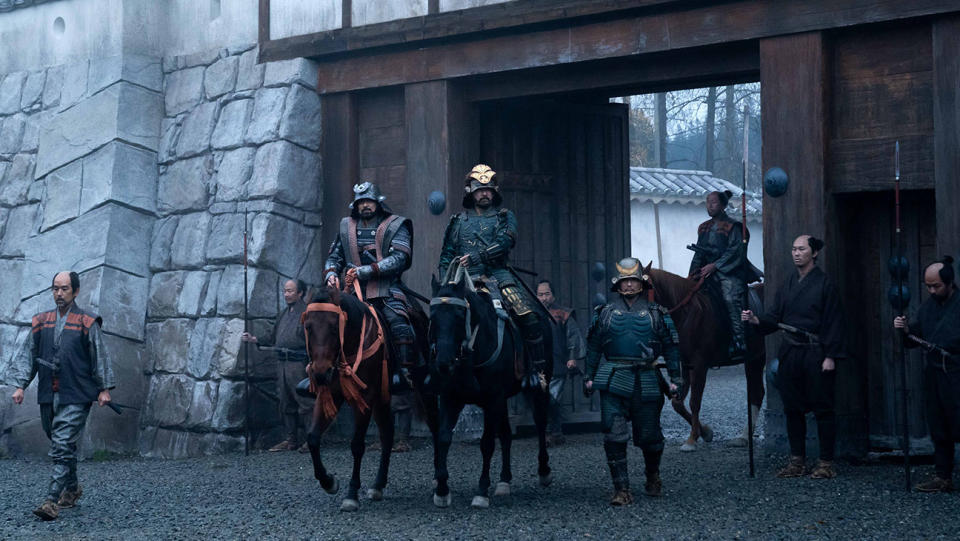‘Shogun’ Star-Producer Hiroyuki Sanada on Epic’s Long Journey to TV and Authentic Set
- Oops!Something went wrong.Please try again later.
- Oops!Something went wrong.Please try again later.

After a career as an actor that started in his childhood years, Hiroyuki Sanada’s latest endeavor — the FX and Hulu epic limited series Shōgun — sees the Japanese star taking on a brand new role as producer.
Not only does Sanada star in the adaptation of James Clavell’s celebrated 1975 novel as Lord Yoshii Toranaga, he also worked tirelessly with co-creators and showrunners Justin Marks and Rachel Kondo on bringing the show to life behind the scenes. By the actor’s own admission, Sanada was the first one on set each day, even when he wasn’t filming; he was chiefly invested in making sure Japanese actors and crew were involved; and through it all, he was clad in his character’s armor. From time to time, Sanada would literally jump out of his character’s scene and into the role of producer, hopping down from his horse and sitting in front of the monitors on a specially crafted chair to accommodate his extravagant costume.
More from The Hollywood Reporter
“I really enjoyed it,” he tells The Hollywood Reporter about the work on the period drama, which is set in 17th century feudal Japan. “I was so happy every day on set.”
Below, Sanada reveals more about the long process involved in bringing the Japanese epic to life on TV, how his work as producer informed his work on camera, possible pathways forward for future seasons, and why he feels Shōgun is a crucial step toward inclusivity industrywide.
***
Tell me about the journey of bringing Shōgun from the page to the screen.
First of all, it was like seven or eight years ago. One of my co-workers, a producer, asked me to play this role and he planned to make it an epic drama with FX. I asked him, “How can you guys create this show in Hollywood? Can you guys hire Japanese actors for Japanese roles? Can we hire Japanese crew, and specialists for each department?” Something like that. They responded in a very positive way. So I said, “Yes, I’ll take this role.”
That was the beginning. A few years passed, and we struggled to get the green light. It pushed a few years. Then Justin and Rachel joined Shōgun, and at that time they asked me to join them as producer, as well. Then I thought, “OK, it’s going to be the first time for me, but it would be a good chance to make this authentic.”
How was that experience? You’re not only producing this huge series, you’re headlining it as well.
I tried my best! First of all, we needed to create an authentic script matching for the modern audiences. Easy to understand, but not Westernized, not modernized too much. Avoid any stereotypical episodes or words or movement or violence, nudity; try to avoid any misunderstanding on the script. Then we hired Japanese crew from Japan, some of them working together over 30, 40 years. Wig specialists, props, masters of gestures, costumes … for each of these departments, I could hire from Japan. We created the team in Japan, and then collaborated with the Western crew and cast.
For casting, Justin asked my opinion for the big important roles before they decided. I suggested and then told them the reasons why this guy or this actress was best. I sometimes changed the role. Some actors took the audition for another role, but I felt, “Oh, this person is matching for another different role. It’s much better.” And then Justin agreed. So, those kind of things before the start of shooting.
For shooting days, I was always on set, even if I wasn’t shooting as an actor. The very beginning of each day, I was the first person on set to check everything: props, decorations, positions, extras, costumes … always checking. Then I called the crew and cast, and the director, and then we’d start rehearsals and give some advice for the movements or positions. And after that I went back to my trailer and I put the wig on, the costume on, and back to set. So, it was fun.
If I went to work with you producing in full armor, I would be pretty intimidated.
Sometimes I was checking the monitor with the full armor. (Laughs.) And then sometimes I’d go back and forth between main unit and second unit, and sometimes just checking the monitor in other sets, and then call to the Japanese crew or assistant director and then correct the position timing, and then go back to in front of a camera … it was a lot of work!

How do you maintain the character within all of that?
Since I spent a long time preparing for this show, I already had an image of the character and also, I had a good chance to learn about this period because I played the role before. [Toranaga] is based on a real shōgun [named Tokugawa Ieyasu], and I’ve done that in Japan before. So I had a good chance to learn the history, the background. But this time, I respected the novel and respected our version of script. So I just focused on following the script and novel more than real history.
When I’m standing in front of the camera as an actor, I felt freedom. Because, before I started acting, I prepared everything with professionals watching each part. So I was so comfortable and confident for the job. I really enjoyed it. It felt like a reward for preparing everything: acting my part, not wasting any movements or explanation. Just be there and react. That was my stance for this time, more than usual. So maybe because I’d done the producing, it affected the acting. Just be there. Simple and deep. That’s it. I really enjoyed both producing and acting. I was so happy every day on set.
What was the atmosphere like on set? Especially considering the scale.
The sets were huge. Each time I saw the new set, I was surprised and so happy. They created whole villages or harbors with the authentic buildings matching for that period; real scales of stone walls, and then people can walk on top of the castles. It was crazy.
Do any of your past experiences match that scale?
Yeah, The Last Samurai was a huge scale and open set. Tokyo streets and whole villages in New Zealand. It was a lot. But this time, Disney and FX spent much money to create great sets, including the ships. We had a real-size ship as an open set. [For a scene depicting a storm at sea,] there was a real-sized ship in the air and then computer controlling the ship 360 degrees, and then real actors onset and then a big water tank up the air and then coming through, moving ship water, and then cast and the camera on the ship. No CGI. We felt like it was a Disneyland attraction. But we had both real sets plus the newest technology, and we mixed them together. So it was fun. Even the postproduction, editing, sound effects … we checked to make sure we did it all correctly and made it look authentic, and we spent a year and a half on it after we finished the shooting. So I’m really happy it’s out now, but also, a little sad.

Right, it was yours for so long, and now it’s ours: the audience’s.
Our newborn ship goes into the ocean, travels to the world alone. (Laughs.) I cannot do anything anymore.
Off to college!
Oh yes, exactly. That feeling, I think. (Laughs.) But the reaction was amazing. Including Japan. I was a little worried about the Japanese reaction because they know what is authentic, and what is not. But surprisingly, all the reviews and the reactions from the audience were great. That was exactly we wanted. We tried to make the audience understand easily, even a Western audience, something they could enjoy and feel. But also, Japanese core samurai drama fans were a very important target this time. So we tried to make this for both core samurai and ordinary Western audiences, for both to enjoy this … that balance was our goal. So for now, we are receiving good reactions from both. Hopefully the people enjoy this show and feel our passion to create this show.
Shōgun is presented as a limited series, but can you imagine telling more stories within this framework?
When we get through episode 10, we’ll finish the novel’s period. No one knows what’s going to happen next. But we have history, real history models, and clearly, we know what happened. So, yeah. It all depends on the audience’s reaction. But as a creator, with so many people watching worldwide and streaming the same day all over the world, it’s so exciting. This kind of project is important to the future. I believe if somebody wants to create stories about other cultures, they should hire a specialist for each culture and actors from each culture. That’s going to be a new normal, I hope.
The 10-episode series launched with the first two episodes; new episodes of Shōgun release weekly on Tuesdays and are available to stream on Hulu and Disney+.
Best of The Hollywood Reporter

